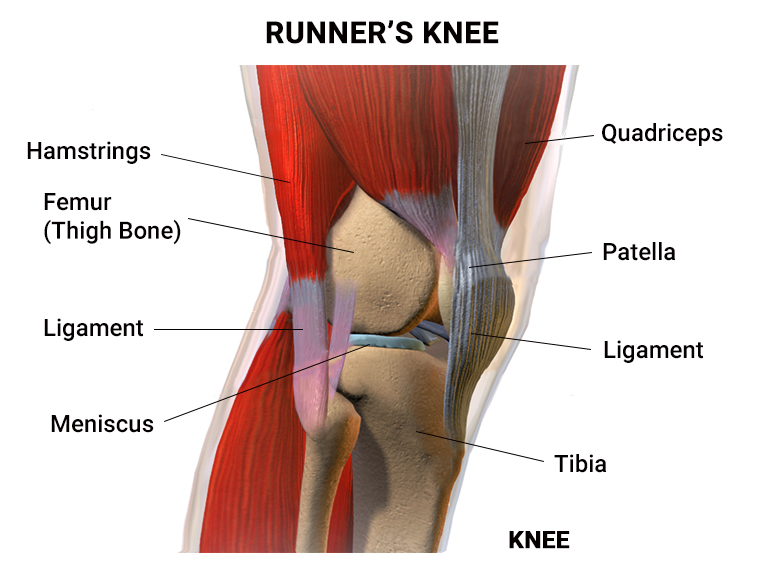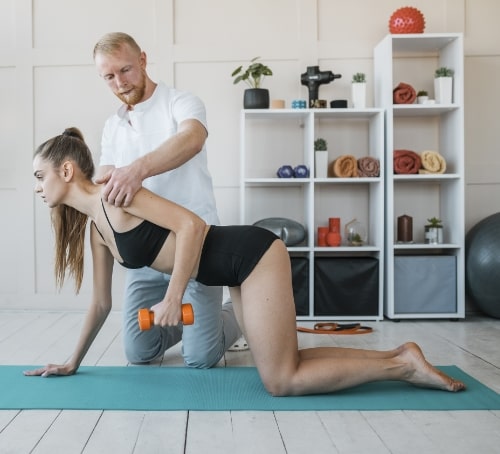Runner’s knee is actually a catchall term that’s used to describe several different conditions that can cause pain around the patella or kneecap. If you’re a runner and have knee pain, it’s likely that you’ll hear the term runner’s knee at some point to describe what you’re experiencing.
What Is Runner’s Knee?
Runner’s knee, also known as patellofemoral pain syndrome, is a condition that causes pain around the kneecap (patella) and the front of the knee. It is a common injury among runners and other athletes who engage in activities that involve repetitive knee movements, such as cycling, jumping, and squatting. Improper form, muscle imbalances, or overtraining often cause it. It can be caused by improper form, muscle imbalances, or overtraining.
Most often your pain can more accurately be diagnosed as one of the following conditions:
- Anterior knee pain syndrome
- Patellofemoral malalignment
- Chondromalacia patella
- Iliotibial band syndrome
You might also hear the term patellofemoral pain or PFP when people talk about the pain you’re experiencing. That’s just another term that’s used as a blanket to include any of the above conditions and it’s a medical way of saying runner’s knee.
Causes of Runner’s Knee (It’s Not Always Running)
While it’s true many people with this diagnosis are actually runners, you don’t have to be a runner to develop this problem and the resultant pain. The causes of runner’s knee can include the following:
- A malalignment of the kneecap
- Excessive training or overuse (which could be related to running)
- Injury or other trauma
- Weak thigh muscles
- Issues with Achilles tendon strength
- Poor foot support (could be bad shoe choices)
- A faulty gait
- Flat feet or high arches
- Tight muscles, particularly in the quadriceps, hamstrings, and IT band
- Overpronation (rolling the foot inward while running)

Wonderful place and very state of the art, highly recommend. Doctors who listen and treat accordingly.
RPFriendly and fun staff, and excellent treatment and service.
BBSymptoms of Runner’s Knee
Runner’s knee usually gets better with rest and top physical therapy to rebuild strength and stamina, but it’s always a good idea to seek professional medical help if you’re experiencing knee pain symptoms to rule out a more serious injury. Some of the symptoms you might experience if you have developed a runner’s knee condition include:
- Pain at the kneecap, around it, or a feeling of soreness under the kneecap
- Knee pain may increase when you’re active
- Pain or weakness upon standing after sitting for a long time
- Kneecap that’s tender to the touch or to pressure
- A grinding sensation of clicking noise when you move your knee
- Swelling or stiffness in the knee
How to Treat Your Runner’s Knee
The best care for runner’s knee is a physical therapy treatment plan that takes into consideration your level of injury and pain, your overall fitness and health, and your age. If you’ve had this condition in the past, that will also play a role in your runner’s knee treatment.
No matter what condition you’re in, your initial treatment will center around rest and giving your knee time to heal. This might even involve runner’s knee taping to help with immobilization and give support to your knee while you navigate your daily living activities. During the rest and recovery portion of care, you can expect some or all of the following:
- Cold packs
- Elevating your leg
- Compression knee wrap
- Knee braces
- Over-the-counter medications to manage inflammation
- A review of your shoes
- A look at your natural gait
- Time off your feet
When the pain is more manageable, you’ll move onto some runner’s knee exercises that will help strengthen the knee and surrounding areas. Learning to rely on the surrounding muscles may play a big role in your recovery and learning to avoid future knee injuries.
Included with runners knee exercises are runners knee stretches. These two techniques work hand-in-hand giving you added flexibility, strength, and increasing your range of motion very slowly. Your physical therapist will work with you to create a customized program that gets you back to the level of fitness you want to be at. The treatment plan will be specific to you and will be flexible enough to change as you progress or if anything proves to be excessive and slowing progress. It’s not a quick fix but our trained team is here to help you recover and enjoy your favorite activities again.
Knee Strengthening Exercises for Runners
While we said that not all runner’s knee diagnoses involve runners, there’s a significant number of people who are runners and develop this type of knee pain. The best way to avoid runner’s knee is to actively work to not get it in the first place. This includes maintaining a health weight, wearing appropriate shoes, using good running form, and always doing stretching and knee strengthening exercises for runners.
Interestingly, while your attention is on your knee, you’ll also want to stretch and strengthen your quads, hip flexors, your calves, and even the buttocks because these areas all work together when you’re running correctly, and they eliminate some of the stress on your knee.
Try these simple knee exercises regularly to support knee flexibility and strength.
- Thigh contractions
- Straight leg raises
- Hamstring stretches
- Iliotibial band stretches
- Gentle knee bends and full squats
- Lunges
These are all strengthening exercises that runners should be familiar with and use regularly, but too many people skip the warm-up and the cool-down. If you’re serious about preventing injury, then these elements of your workout should always be included.
Consultation For Runner’s Knee

If you have a runner’s knee, there is no need to suffer from pain and limited range of motion. Don’t delay your appointment with a skilled team of physical therapists at our clinic. Feel free to contact Physical Therapists NYC and get the desired relief from a runner’s knee. You can live the life you want with the help of the full range of physical therapy procedures we offer. Connect with our office to schedule an appointment to meet your new physical therapist today.

Dr. Hetarth Kapadia is a licensed physical therapist that has extensive experience working with orthopedic, neurological, and cardiovascular patients, bringing a wealth of knowledge and expertise to the practice.
Dr. Hetarth Kapadia received his Bachelor's degree in physical therapy from S.B.B. College Of Physiotherapy and his Master's degree in Kinesiology from California Baptist University, Riverside, California, with a major in Exercise Science.
Dr. Hetarth is now pursuing his Doctorate in Physical Therapy at Touro College in New York. Before becoming a part of our practice, he worked in New York at various outpatient clinics where he dealt with patients with musculoskeletal and orthopedic disorders.
More about Dr. Kapadia




